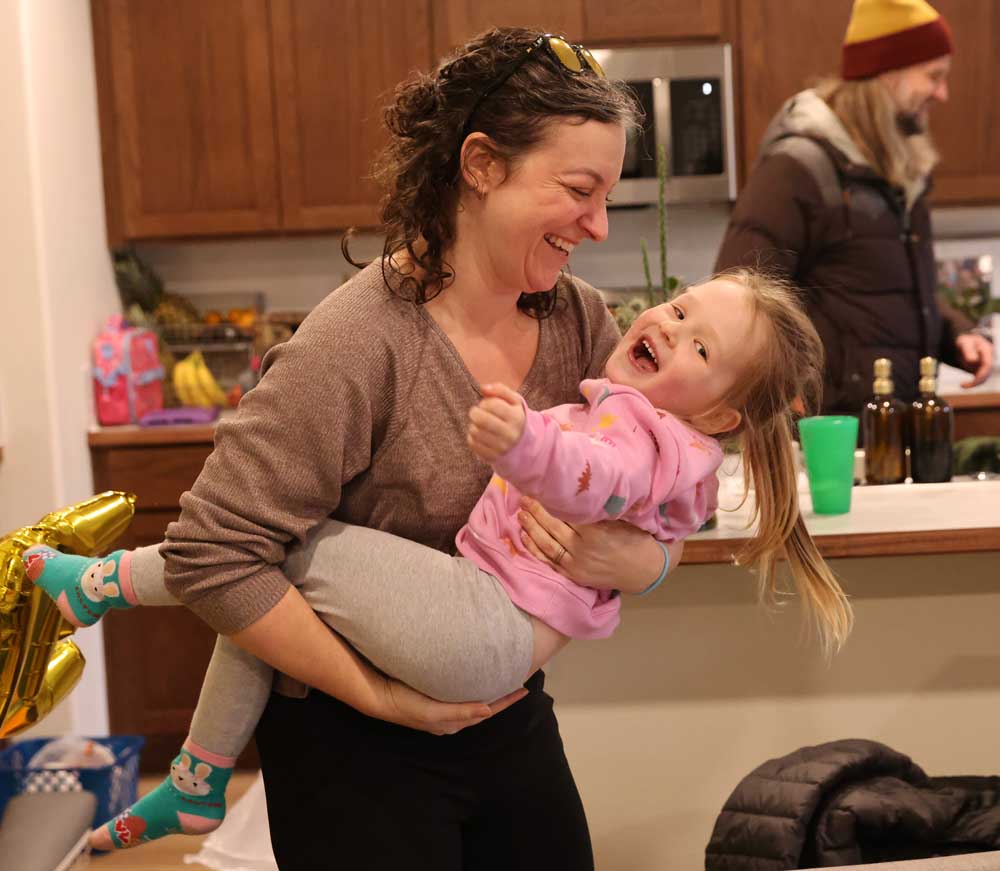Bend family gets increasingly rare chance at homeownership
Published 9:30 am Wednesday, November 27, 2024

- Megan Stith and her daughter Ebba, 3, embrace while moving into their new home in Bend.
Seven years ago, Megan and Troy Stith took a chance.
As a couple in their early 30s living and working in downtown Columbus, Ohio, they pondered what was next in their life. They wanted to leave Ohio and the city for a slower life to be closer to nature.
So they sold almost everything they owned and took off in a Subaru Crosstrek.
“We had no idea where we were going to land,” Troy said.
They camped and parked in as many cities as they could, from New England to Denver to the West Coast.
After four months of traveling, the couple landed in Bend and never left. But it wasn’t until Monday afternoon, when a U-Haul truck piled high with cardboard boxes pulled into their driveway in southeast Bend, that it was clear their gamble paid off.
Thanks to an assistance program that aims to counteract rising home prices that have put homeownership out of reach for many families in Central Oregon, the Stiths now own a home in Bend. They’re hosting a Thanksgiving meal with family visiting from Ohio. And they have much to be thankful for.
“It just feels like we’ve been getting to this day forever and it’s finally come,” Troy said.
“It feels like we can finally put down some roots,” Megan said.
Housing dreams slip away
For many young families in Bend and Central Oregon, soaring costs have put hopes of homeownership out of reach.
That was almost the case for the Stiths.
Buying a home seemed attainable when the couple first started browsing the market in 2019. The median home price in Bend remained below $500,000 that year. The Stiths put in offers on a few homes with a $400,000 budget, but nothing panned out.
As Central Oregon grows, people struggle to set down roots
The search was put on pause when the pandemic hit and the Stiths both lost their jobs at local companies, Troy as a product manager for Silipint, a flexible silicon cup manufacturer, and Megan at Buzztag, a promotional products company.
They had a daughter, Ebba, in 2021. They continued to rent an apartment at a reasonable price on the east side of Bend, but watched as neighboring duplexes were sold and returned to the market with staggering rent increases.
They felt stuck. Circling back to the housing search, their dreams started to slip away as median home costs climbed into the upper $700,000s.
Bend’s median home price hit $800,000 this month, according to the Beacon Report, a Central Oregon real estate analysis. According to city of Bend data, 16% of households can afford to buy a home in Bend without facing a burden from monthly housing costs.
As climbers and mountain bikers, the Stiths fell in love with Bend’s outdoor offerings. People said hello when walking down the street, and cars stopped for pedestrians — exactly the change they wanted from big city life.
But without housing, the future in Bend seemed grim.
“We don’t want to be renters forever,” Megan said. “If this is the reality of living here, we can’t. We can’t buy a house here. If that’s our dream, we have to go somewhere else. That’s not something we wanted to do, but it was the reality of the situation, which was hard.”
A ‘Hail Mary’
Staying in Bend took persistence and good fortune.
After attending a housing fair at 10 Barrel Brewing, they applied for the homeownership program through First Story, a nonprofit created by Hayden Watson, founder of housing developer Hayden Homes. First Story offers 30-year loans with no interest and no down payment to households earning less than 80% the area median income.
Bend code changes to spur affordable housing raise concerns
The Stiths poured hours into applying for the program, explaining their story with biographical essays and attending homeownership classes.
“It was really our Hail Mary to stay in Bend,” Troy said.
They were surprised with the news about their new home in October 2023. But the house still needed building.
First Story partnered with Heart of Oregon Youthbuild, a workforce development program for low-income young people.
First Story relies on donations of labor, land and materials to build homes. The nonprofit is funded by a long list of donors and contributions to a payroll giving program by Hayden Homes employees, which is matched by the company.
The space is growing in Central Oregon for nonprofits that sell affordable and middle-class housing at prices far below what the market is demanding, with several new organizations popping up in the last few years. First Story is the only nonprofit that doesn’t rely on various government subsidies to lower home costs.
The Stith’s 1,400-square-foot three-bedroom home cost $375,000 and is on one of 13 lots in the southeast Bend neighborhoods for homes built by First Story. About half of the houses have been built.
The wait is finally over for the Stiths. Troy is preparing to make his mother’s prized mashed potato recipe. Megan is excited to carry on the tradition of cooking homemade pizzas on Christmas.
Three-year-old Ebba, who recently started preschool, is glad to be sleeping across the hall from her parents in a bedroom upstairs, freshly painted with pink walls. She’s happy to have more room to play with her stuffed dog, Lucy, and more room outside in the yard, where she wants to plant seeds for a cherry tree.








